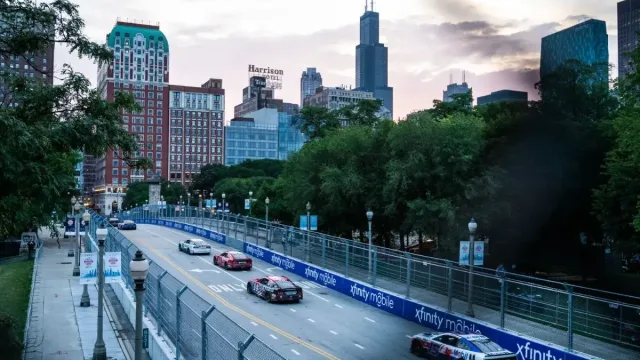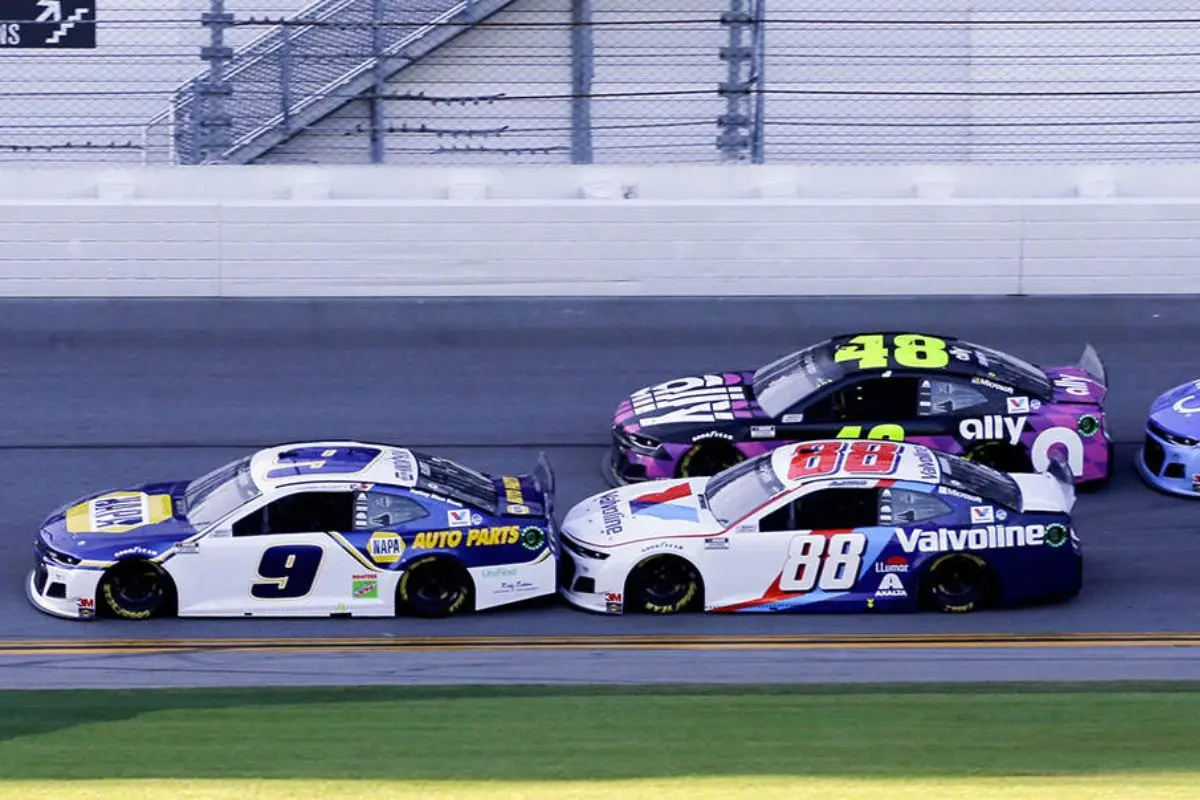NASCAR to End Chicago Street Race: NASCAR’s bold attempt at a street race in Chicago brought thrills, challenges, and questions. After two years of costly struggles, fans are left wondering: was it all worth it? The Chicago Street Race promised excitement and drew a crowd, but behind the scenes, financial hurdles and unpredictable weather caused big headaches. Now, as NASCAR nears the end of its Chicago commitment, one mystery remains—what’s next for the sport’s boldest experiment?
Key Highlights
- NASCAR might withdrew from the Chicago street race due to substantial financial losses and unsustainable investment returns.
- The event generated over $128 million in economic activity but failed to achieve profitability for NASCAR.
- Challenges included weather disruptions, low spectator turnout, and competition from other entertainment options in Chicago.
- NASCAR plans to focus on new locations that align better with strategic goals and financial viability.
- Future expansion efforts will prioritize sustainable growth and fan engagement in both domestic and international markets.
NASCAR’s Bold Move with the Chicago Street Race
In a tactical attempt to diversify its racing portfolio and engage a broader audience, NASCAR ventured into new terrain with the Chicago Street Race. This calculated departure from the traditional oval circuits was designed to capture the excitement synonymous with street racing, a staple in the world of open-wheel racing such as Formula 1. The initiative aimed to change the streets of Chicago into a dynamic racing venue, complete with the bustling ambiance of a major city backdrop, thereby promising a unique spectacle.
NASCAR’s foray into street racing was not merely about the race itself but about creating a must-see event that could captivate both die-hard fans and newcomers similarly. The Chicago Street Course was envisioned as a bold experiment, one that sought to infuse the sport with fresh energy and broaden its appeal beyond its conventional fan base. The ambition was clear: to craft a racing experience that resonates with the urban energy of Chicago while maintaining the core values of NASCAR.
However, the choice to adopt street racing brought with it a wave of skepticism from traditionalists who questioned whether NASCAR was straying too far from its roots. The question lingered: was the allure of street racing enough to justify the considerable investment?
As NASCAR reflects on the past few years, the initial promise of the Chicago Street Race as a game-changing event has been met with mixed results. While the spectacle attracted attention, the overall impact on fan engagement and the broader NASCAR brand remains a topic of critical evaluation.
Challenges and Economic Impact of the Chicago Street Race
Facing a complex array of challenges, the Chicago Street Race has presented both opportunities and hurdles for NASCAR’s expansion strategy. The event marked a notable cultural and economic footprint, drawing 79,299 fans in its inaugural year and generating $128 million in economic activity in 2024—a 17% increase from 2023. However, the path was fraught with obstacles, including inclement weather that led to the cancellation of concerts and the shortening of races. Despite the setbacks, the excitement on the track, exemplified by Shane van Gisbergen’s debut win in the ‘Grant Park 165,’ kept the audience engaged both locally and worldwide.
The economic enhancement to Chicago was evident, yet, financially, the event has been a challenging venture for NASCAR. The organization invested approximately $50 million each year, without yielding profitability. NASCAR President Steve Phelps acknowledged the financial difficulties, emphasizing the mixed results of this ambitious endeavor. The street race concept, while still supported by the France family, has not delivered the expected financial returns.
The Chicago Street Race demonstrated the potential for street racing as a spectator draw and economic stimulant but also highlighted the fiscal risks involved. While the event captured a diverse audience from 15 countries and all 50 states, achieving a sustainable financial model proved elusive, prompting NASCAR to reconsider its investment strategy in urban racing events. This experience serves as a critical case study in balancing cultural ambition with economic viability.
Potential New Venues and International Opportunities
The resolution of NASCAR’s involvement with the Chicago Street Race has ushered in a new phase of exploration for the organization, as it evaluates potential new venues and international opportunities to expand its reach. This shift comes at a critical time when global motorsport markets are burgeoning, particularly in regions like the Middle East.
“If it’s the right thing to do to grow the sport, I think NASCAR and the France family have shown that they’re going to invest.” – Steve Phelps
One intriguing possibility on NASCAR’s radar is Saudi Arabia, where the ambitious Qiddiya entertainment city is set to house a state-of-the-art Speed Park, slated for opening in 2028. This venue presents a compelling opportunity for NASCAR to potentially bring its storied racing series to a new audience.
Despite the allure of Saudi Arabia’s burgeoning motorsport infrastructure, NASCAR’s Chief Operating Officer, Steve O’Donnell, emphasizes the organization’s broader tactical vision. O’Donnell notes, “I wouldn’t put it specifically on Saudi. We’ve got a finite amount of content we can bring, but I think as you look at NASCAR from an international standpoint, it’ll be more around that Mexico model.”
This indicates NASCAR’s intent to foster a sustainable and grassroots presence in new markets rather than relying solely on marquee events. The Mexico model, referenced by O’Donnell, highlights a strategy focused on cultivating local engagement and building a resilient fan base.
Southern California as a Potential Street Race Venue
Amid the evolving landscape of NASCAR’s venue exploration, Southern California emerges as a compelling contender for a potential street race, utilizing its rich motorsports culture and established fan base.
Historically, the region has been a hotbed for racing enthusiasts, supported by successful events such as the Long Beach Grand Prix, a staple in the IndyCar series. This legacy, combined with high-profile events like San Diego’s GT World Challenge America, highlights Southern California’s capability to host major motorsport events.
Steve O’Donnell, NASCAR’s executive, has acknowledged the tactical allure of the Southern California market. His comments suggest an exploratory interest, noting, “We are certainly interested in California and the Southern California market, and that will continue to be a focus for us, but nothing to confirm at this point.”
This indicates a recognition within NASCAR of the region’s potential to boost its racing portfolio, particularly given the passionate fan base that could drive considerable local engagement and economic impact.
The logistical and cultural advantages of a Southern California street race are manifold. From a logistical standpoint, the infrastructure and existing expertise in hosting large-scale motorsport events present a solid foundation.
Lessons Learned and Future of Street Racing
While the Chicago Street Race has provided NASCAR with invaluable insights into the intricacies of street racing, the learnings from this venture are shaping the organization’s approach to future events. The experience has highlighted the complex logistics and unpredictable elements inherent in urban street racing. As NASCAR gears up for the final year of its Chicago commitment in 2025, several key lessons have emerged that will inform its plan moving forward.
- Adaptability and Flexibility: The Chicago Street Race illustrated the necessity of adaptability in both planning and execution. Weather-related disruptions required quick adjustments and emphasized the importance of having contingency plans.
- Event Format Evolution: Continuous tweaking of the event format to improve spectator experience and operational efficiency was essential. These adjustments reflect NASCAR’s commitment to evolving and perfecting its approach to street racing.
- Investment vs. Return: The high costs associated with street racing events demand a thorough evaluation of return on investment. Despite the potential for high visibility, careful financial scrutiny is significant to determine the sustainability of such ventures.
- Exploration of New Markets: NASCAR’s interest in exploring new venues, both domestically and internationally, highlights a tactical push to diversify its audience.
“We’ve learned things each and every year,”
“It’s our first street race, a lot of learnings came from that. A lot of weather challenges as well. … We’ve made some tweaks to the event format and continuing to evolve that as well.” – Steve O’Donnell
News in Brief: NASCAR to End Chicago Street Race
The decision to sever ties with the Chicago street race emphasizes NASCAR’s tactical recalibration in response to economic and logistical challenges. Analyzing the implications of this move highlights the potential for exploring new venues, including international markets and Southern California, which may offer more sustainable opportunities. The lessons learned from the Chicago experience will likely inform future endeavors, as NASCAR seeks to refine its approach to street racing, balancing innovation with practical considerations and ensuring long-term viability.
ALSO READ: Chicago Street Race Protesters Got Arrested for Causing Chaos



